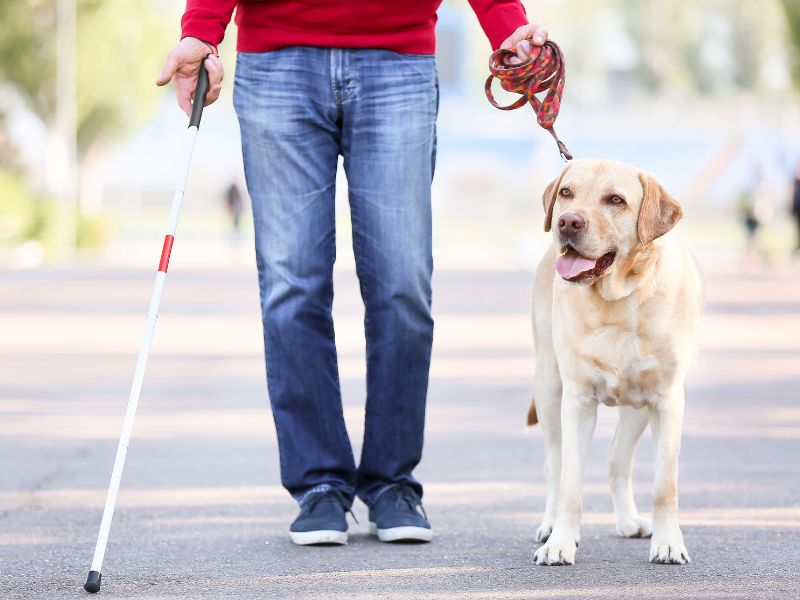
Labradors are beloved worldwide for their sociable nature, loyalty, and smarts. Nonetheless, owners might find themselves scratching their heads when their usually obedient Lab suddenly starts to act up. There are a few reasons why a Labrador might display disobedient behavior. Firstly, your furry friend might not comprehend what you’re asking of him. Since dogs don’t speak human, it’s crucial to communicate with them on their level. Secondly, lack of physical activity can also lead to unruly behavior in Labradors, as they are a lively breed in need of ample exercise to thrive. Lastly, disobedience could also indicate underlying health issues that demand attention, like pain or discomfort.

Labradors are smart dogs, but they don’t comprehend English, so it’s essential to teach them the behaviors you desire. Effective communication is key for dogs to understand your expectations clearly and consistently. Without proper training, your Labrador may become confused and disobedient, causing frustration for both you and your pet. To ensure your Labrador grasps what you want, utilizing positive reinforcement is crucial. Rewarding good behavior with treats or praise can help your furry friend learn what you expect. It’s vital to remain patient and unwavering in your training approach. Consistent repetition is necessary, as it may take time for your Labrador to pick up new commands. A common mistake to avoid is using too many words or commands. Keep it simple with one-word instructions like “sit” or “stay.” This simplifies the communication process, making it easier for your dog to comply with your commands. In summary, if your Labrador is displaying disobedience, it could be due to a lack of understanding. By incorporating positive reinforcement and straightforward commands, you can help your furry companion learn what is required of them, leading to a more joyful and obedient dog.

Labrador owners may encounter unfamiliar terminology when delving into their dog’s behavior research. It’s crucial to grasp these terms in order to effectively communicate with trainers and veterinarians. Here are some common terms and their definitions: 1. Obedience: Refers to a dog’s capability to follow commands given by its owner. 2. Stubbornness: Indicates a dog’s tendency to ignore commands it has been taught to obey. 3. Exercise: Physical activities that aid in maintaining a dog’s overall health and well-being. 4. Positive reinforcement: A training method that rewards a dog for displaying good behavior. 5. Negative reinforcement: A training tactic that eliminates an unpleasant stimulus when a dog behaves well. 6. Punishment: Involves applying an unfavorable stimulus when a dog behaves poorly. With a good understanding of these terms, Labrador owners can effectively comprehend their dog’s behavior and collaborate with trainers to enhance obedience. It’s worth noting that modern training techniques often take a different, more positive approach compared to older methods.

Does modern dog training mean the same thing everywhere? No, it has evolved over time and varies from traditional methods. Instead of punishment and negative reinforcement, modern training relies on positive reinforcement. This involves rewarding good behavior with treats, toys, and praise, motivating dogs to learn and repeat positive actions. Understanding a dog’s body language and behavior is also essential, as it helps tailor training methods to suit the dog’s personality and needs. Overall, modern training is a more humane and effective approach that strengthens the bond between dogs and their owners.

Dogs can sometimes be stubborn because they do not automatically assume that a command given in one place or situation carries the same meaning elsewhere. For instance, a Labrador can be taught to twirl around when told “spin” in the kitchen, but might not respond the same way when given the command elsewhere. This is because dogs heavily rely on environmental cues and context to understand commands, and may struggle to grasp that a word has the same meaning in different settings. To prevent confusion, it is crucial to train a Labrador in various environments and conditions to ensure they comprehend commands no matter the situation. Consistency in commands and cues is also key to preventing disobedience. If an owner uses “down” to signify laying down and then later uses it to mean getting off the couch, the Labrador may struggle to understand and comply. By maintaining consistent commands and cues, the Labrador will be better equipped to comprehend their expectations in different scenarios. Another factor that can contribute to a dog’s disobedience is a lack of motivation to follow commands. If a dog does not see the benefit or reward in obeying, they may be less inclined to do as asked. Regular positive reinforcement and using rewards that motivate the dog can help increase their willingness to listen and behave as desired.

Labradors are known for their trainability, but they can also be stubborn at times, which may be due to a lack of motivation. Just like people, dogs need motivation to perform tasks. If they don’t see any benefits or rewards from obeying a command, they may be less inclined to do so. To motivate your Labrador, it’s important to figure out what they enjoy. Whether it’s treats or playing with toys, using their favorite things as rewards for good behavior can be very effective. Making training sessions fun for your dog is also crucial in increasing their motivation to obey. Incorporating games and play into their training routine can make them more engaged and willing to participate. By understanding what motivates your Labrador and making training enjoyable, you can have a happier and more obedient dog. Renowned dog trainer Pippa Mattinson offers some helpful tips for training your Labrador to be well-behaved. Consistency, positive reinforcement, and clear commands are key elements in successful training. Establishing a routine, rewarding good behavior, and using simple commands can make a big difference in your Labrador’s obedience. Remember, patience, persistence, and positivity are essential when training your Labrador. By following these tips, you can help your furry friend become a well-behaved and obedient companion. And remember, harder tasks can lead to better rewards in the long run.

Labradors are known for their intelligence and trainability, but they can also be stubborn and disobedient if not properly trained. One effective method for training Labradors is through a reward-based system, where the dog is praised and rewarded for good behavior rather than punished for bad behavior. An important aspect of this training method is to gradually increase the difficulty of the tasks given to the dog. Starting with simple commands and rewarding the dog for successfully completing them sets a strong foundation. As the dog progresses and becomes more proficient, tasks can become more challenging, with rewards becoming more substantial. For instance, when teaching a Labrador to sit on command, the owner can begin by asking the dog to sit for short periods and rewarding them with a treat. With practice, the duration of the sit command can be extended, eventually leading to sitting in distracting environments. It’s essential to ensure that the rewards match the difficulty of the task at hand. If the task is too easy, the reward may not be motivating enough. Conversely, if the task is too difficult, the dog may become frustrated. By gradually increasing both the difficulty of tasks and rewards, owners can help their Labradors develop good behavior and obedience. Ultimately, the success of the training lies in the hands of the dog.

Labradors are known for their intelligence, but they can also be prone to disobedience when they feel like they are in control. If your Labrador is ignoring your commands, it may be because they believe they know best. In order to regain control, it’s crucial to establish yourself as the leader of the pack. One effective way to do this is by using positive reinforcement techniques to reward good behavior. This can involve giving treats or praise when your dog follows your commands. Consistency is key in this approach to help your dog understand what is expected of them. Using confident body language and a firm voice can also help establish your authority. Avoid using harsh methods like yelling or hitting, as this can create fear and aggression in your dog. Seeking help from a professional dog trainer or behaviorist may be necessary in more challenging cases to address any underlying issues causing the disobedience. Ultimately, it’s important to remember that your dog has the final say in whether they choose to follow your commands. By reinforcing positive behavior and asserting your leadership, you can increase the chances of your Labrador obeying you, even when they are overly excited.

Labradors are known for their abundant energy levels, which can sometimes result in disobedience. When a pup is overly excited, staying focused on tasks can be a challenge. This tends to be more prominent in younger or untrained dogs. To ensure your Labrador stays on track, it’s crucial to offer them sufficient physical and mental stimulation. Engaging in activities like games of fetch, leisurely walks, and obedience training sessions can help redirect their energy. By providing an outlet for their exuberance, you can assist them in remaining calmer and more attentive when it comes to following your cues. In addition, it’s vital to steer clear of overwhelming your furry friend with excessive stimuli. This includes steering clear of loud noises, sudden movements, or an overwhelming amount of attention. Maintaining a tranquil and predictable environment can aid in keeping your pooch focused and compliant. At the end of the day, it’s essential to recognize that each dog is unique, and what may work for one may not work for another. By comprehending your dog’s individual requirements and disposition, you can help shape them into a mannerly and responsive companion. Is Your Dog Truly Misbehaving? Probably not.

Labradors are well-known for their friendly and obedient nature, but sometimes they may exhibit disobedient behavior. It’s important to understand that a disobedient Labrador does not necessarily mean they are a bad dog. There could be various reasons why a Labrador is not following commands. One possible reason is a lack of training. Since dogs do not speak English, it’s crucial to communicate with them in a way that they can comprehend. A well-trained Labrador is more likely to behave appropriately and respond to commands. Another reason for disobedience could be due to a lack of exercise or mental stimulation. Labradors are high-energy dogs and require regular physical activity to maintain their health and happiness. Insufficient exercise may lead to boredom and restlessness, resulting in disobedient behavior. Additionally, fear or anxiety could also contribute to disobedience in Labradors. If a Labrador is feeling scared or anxious, they may not be able to follow commands. Identifying and addressing the source of their fear through positive reinforcement training is essential in such cases. Overall, it’s important to remember that a disobedient Labrador can be corrected with the right training, exercise, and positive reinforcement. With proper care and attention, they can become well-behaved and obedient companions. For readers interested in learning more about Labradors, there are several resources available to help with training and care. “Labrador Retriever Training Tips” by the American Kennel Club offers valuable advice on training techniques, socialization, and obedience training. If dealing with jumping behavior, “How to Stop Your Labrador from Jumping Up” provides useful tips on curbing this habit. Lastly, “10 Fun Things to Do with Your Labrador” suggests exciting activities to enjoy with your energetic furry friend. By exploring these resources, readers can gain more insight into Labradors and how to best care for them. Whether dealing with disobedience issues or seeking fun activities to do with their furry companions, these articles offer useful tips and guidance.


